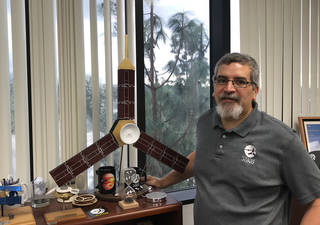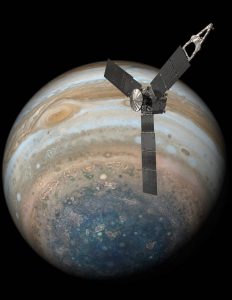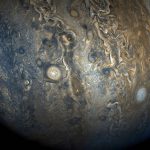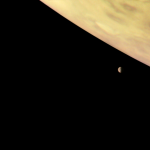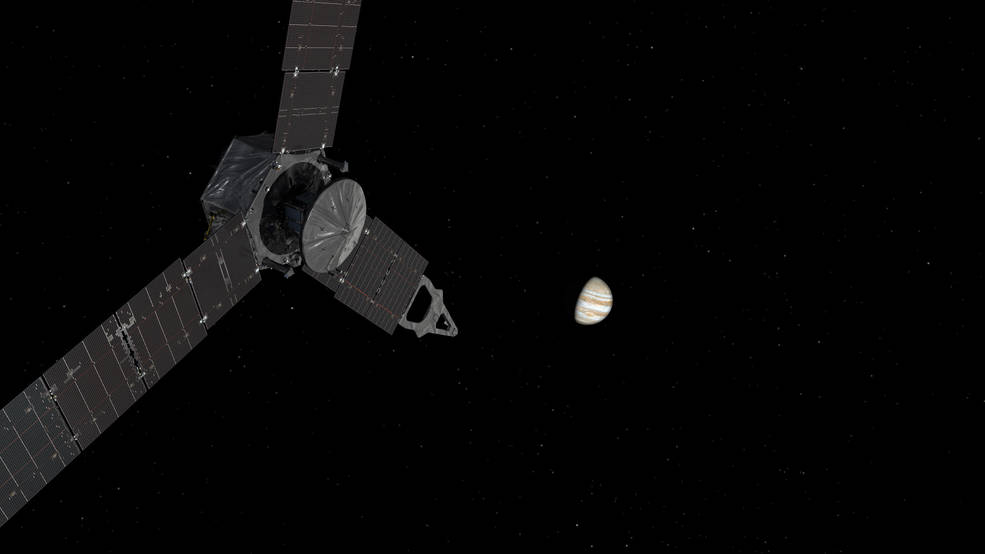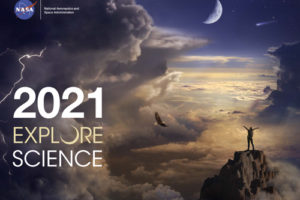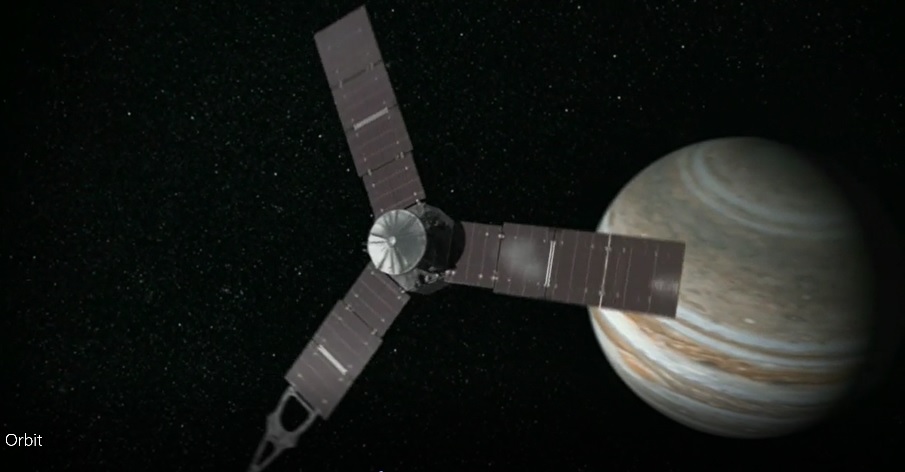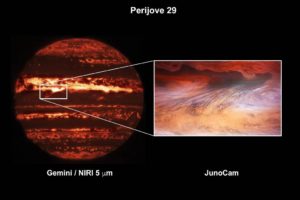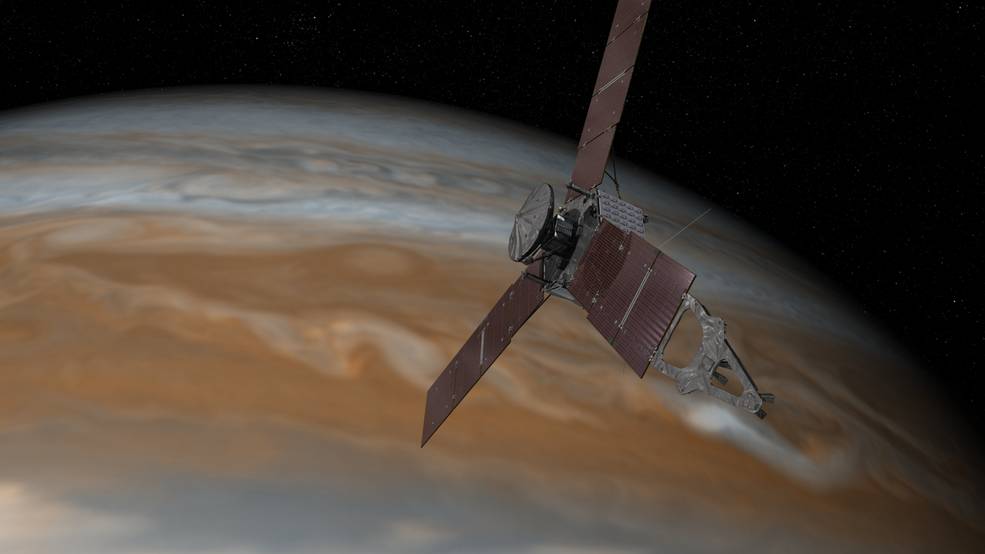久々の更新ですが、今回は特に新情報ということではなく、JPL内部の人事の件でした。
NASAの木星探査機ジュノーの木星最接近は8回目も無事終了したと伝えています。
その割に最近は新情報の公開がなされていません。
上記画像も2017年7月11日公開されたものです.
次回のジュノーの木星最接近は2017年12月16日になるそうです。
はやく大赤斑や木星内部の解析結果を開示して欲しいものです。
ジュノーの新しいプロジェクトマネージャーが任命されました
Juno Aces Eighth Science Pass of Jupiter, Names New Project Manager
Data returned Tuesday, Oct. 31, indicate that NASA’s Juno spacecraft successfully completed its eighth science flyby over Jupiter’s mysterious cloud tops on Tuesday, Oct. 24. The confirmation was delayed by several days due to solar conjunction at Jupiter, which affected communications during the days prior to and after the flyby.
10月31日火曜日に受診されたNASAの木星探査機ジュノーからのデータによると、10月24日火曜日に8回目となる木星の神秘的な大気上空通過と前後数日にわたる科学観測が成功裏に完了したことが確認されました。
Solar conjunction is the period when the path of communication between Earth and Jupiter comes into close proximity with the Sun. During solar conjunction, no attempts are made to send new instructions or receive information from Juno, as it is impossible to predict what information might be corrupted due to interference from charged particles from the Sun. Instead, a transmission moratorium is put into place; engineers send instructions prior to the start of solar conjunction and store data on board for transmission back to Earth following the event.
太陽による通信障害は、地球と木星の間の通信経路上に太陽が位置する際に生じます。ソーラー接続時には、太陽による通信障害時には太陽からの荷電粒子の干渉によってどのデータが壊れているか予測不可能であるため、新しい指示を送信したり、ジュノーからデータを受信したりすることを中断し、送信停止します。技術者たちは太陽の位置を確認して事前に指示を送信しておき、地球に送信するイベントのデータをジュノー搭載の基板上のメモリに保存しておきます。
“All the science collected during the flyby was carried in Juno’s memory until yesterday, when Jupiter came out of solar conjunction,” said the new Juno project manager, Ed Hirst, from NASA’s Jet Propulsion Laboratory in Pasadena, California. “All science instruments and the spacecraft’s JunoCam were operating, and the new data are now being transmitted to Earth and being delivered into the hands of our science team.”
Hirst has worked on Juno since its preliminary design phase, through launch in 2011 and arrival at Jupiter in 2016. He previously worked on NASA’s Galileo, Stardust and Genesis missions. Born in Guatemala City, Guatemala, he earned a B.S. in Aerospace Engineering from the University of Texas at Austin and joined JPL in 1993. Hirst succeeds Rick Nybakken, who was recently appointed deputy director for JPL’s Office of Safety and Mission Success.
“We couldn’t be happier for Rick and know he will continue to do great things to further NASA’s leadership in space exploration,” said Scott Bolton, Juno’s principal investigator from the Southwest Research Institute in San Antonio. “Similarly, we are pleased with Ed’s promotion to project manager. He has been a critical part of Juno for many years and we know he’ll hit the ground running.”
Juno’s next close flyby of Jupiter will occur on Dec. 16.
“There is no more exciting place to be than in orbit around Jupiter and no team I’d rather be with than the Juno team,” said Hirst. “Our spacecraft is in great shape, and the team is looking forward to many more flybys of the solar system’s largest planet.”
Juno launched on Aug. 5, 2011, from Cape Canaveral, Florida, and arrived in orbit around Jupiter on July 4, 2016. During its mission of exploration, Juno soars low over the planet’s cloud tops — as close as about 2,100 miles (3,400 kilometers). During these flybys, Juno is probing beneath the obscuring cloud cover of Jupiter and studying its auroras to learn more about the planet’s origins, structure, atmosphere and magnetosphere.
JPL manages the Juno mission for the principal investigator, Scott Bolton, of Southwest Research Institute in San Antonio. The Juno mission is part of the New Frontiers Program managed by NASA’s Marshall Space Flight Center in Huntsville, Alabama, for the Science Mission Directorate. Lockheed Martin Space Systems, Denver, built the spacecraft. JPL is a division of Caltech in Pasadena, California.
More information on the Juno mission is available at:
https://www.nasa.gov/juno
https://www.missionjuno.swri.edu
The public can follow the mission on Facebook and Twitter at:
http://www.facebook.com/NASAJuno
DC Agle
Jet Propulsion Laboratory, Pasadena, Calif.
818-393-9011
agle@jpl.nasa.gov
Dwayne Brown / Laurie Cantillo
NASA Headquarters, Washington
202-358-1726 / 202-358-1077
dwayne.c.brown@nasa.gov / laura.l.cantillo@nasa.gov
2017-287
Last Updated: Nov. 3, 2017
Editor: Tony Greicius
